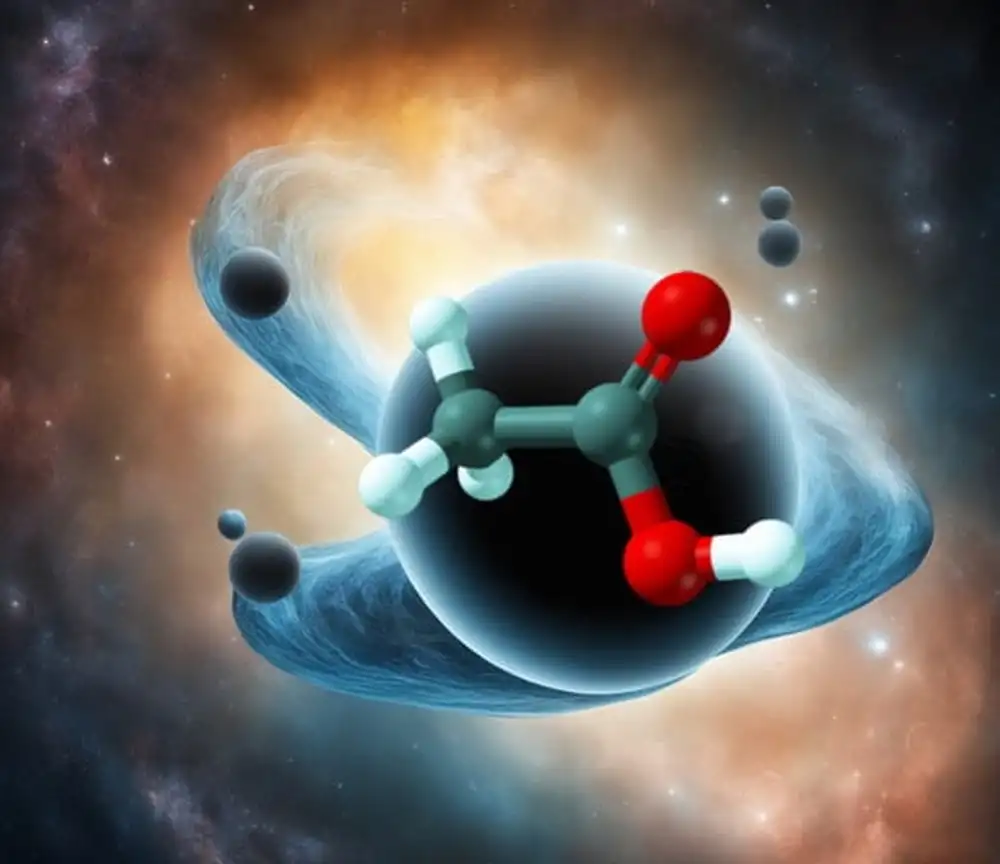
If you were to throw a message in a bottle into a black hole, all of the information in it, down to the quantum level, would become completely scrambled. Because in black holes this scrambling happens as quickly and thoroughly as quantum mechanics allows, they are generally considered nature’s ultimate information scramblers.
But new research from Rice University theorist Peter Wolynes and University of Illinois Urbana-Champaign collaborators Martin Gruebele and Nancy Makri has shown that molecules can be as formidable at scrambling quantum information as black holes. Combining mathematical tools from black hole physics and chemical physics, they have shown that quantum information scrambling takes place in chemical reactions and can nearly reach the same quantum mechanical limit as it does in black holes. The work is published online in the Proceedings of the National Academy of Sciences.
“This study addresses a long-standing problem in chemical physics, which has to do with the question of how fast quantum information gets scrambled in molecules,” Wolynes said. “When people think about a reaction where two molecules come together, they think the atoms only perform a single motion where a bond is made or a bond is broken.
“But from the quantum mechanical point of view, even a very small molecule is a very complicated system. Much like the orbits in the solar system, a molecule has a huge number of possible styles of motion ⎯ things we call quantum states. When a chemical reaction takes place, quantum information about the quantum states of the reactants becomes scrambled, and we want to know how information scrambling affects the reaction rate.”
To better understand how quantum information is scrambled in chemical reactions, the scientists borrowed a mathematical tool typically used in black hole physics known as out-of-time-order correlators, or OTOCs.

“OTOCs were actually invented in a very different context about 55 years ago, when they were used to look at how electrons in superconductors are affected by disturbances from an impurity,” Wolynes said. “They’re a very specialized object that is used in the theory of superconductivity. They were next used by physicists in the 1990s studying black holes and string theory.”
OTOCs measure how much tweaking one part of a quantum system at some instant in time will affect the motions of the other parts ⎯ providing insight into how quickly and effectively information can spread throughout the molecule. They are the quantum analog of Lyapunov exponents, which measure unpredictability in classical chaotic systems.
“How quickly an OTOC increases with time tells you how quickly information is being scrambled in the quantum system, meaning how many more random looking states are getting accessed,” said Martin Gruebele, James R. Eiszner Endowed Chair in Chemistry at Illinois and a co-author on the study who is part of the joint Rice-Illinois Center for Adapting Flaws as Features funded by the National Science Foundation.
“Chemists are very conflicted about scrambling in chemical reactions, because scrambling is necessary to get to the reaction goal, but it also messes up your control over the reaction," Gruebele explained. “Understanding under what circumstances molecules scramble information and under what circumstances they don’t, potentially gives us a handle on actually being able to control the reactions better. Knowing OTOCs basically allows us to set limits on when this information is really disappearing out of our control and conversely when we could still harness it to have controlled outcomes.”
In classical mechanics, a particle must have enough energy to overcome an energy barrier for a reaction to occur. However, in quantum mechanics, there’s the possibility that particles can “tunnel” through this barrier even if they don’t possess sufficient energy. The calculation of OTOCs showed that chemical reactions with a low activation energy at low temperatures where tunneling dominates can scramble information at nearly the quantum limit, like a black hole.
Nancy Makri, Edward William and Jane Marr Gutgsell Chair and professor of Chemistry at Illinois, used path integral methods she has developed to study what happens when the simple chemical reaction model is embedded in a larger system, which could be a large molecule’s own vibrations or a solvent, and tends to suppress chaotic motion.
“In a separate study, we found that large environments tend to make things more regular and suppress the effects that we’re talking about,” Makri said. “So we calculated the OTOC for a tunneling system interacting with a large environment, and what we saw was that the scrambling was quenched ⎯ a big change in the behavior.”

One area of practical application for the research findings is to place limits on how tunneling systems can be used to build qubits for quantum computers. One needs to minimize information scrambling between interacting tunneling systems to improve the reliability of quantum computers. The research could also be relevant for light-driven reactions and advanced materials design.
“There’s potential for extending these ideas to processes where you wouldn’t just be tunneling in one particular reaction, but where you’d have multiple tunneling steps, because that’s what’s involved in, for example, electron conduction in a lot of the new soft quantum materials like perovskites that are being used to make solar cells and things like that,” Gruebele said.
Wolynes is Rice’s D.R. Bullard-Welch Foundation Professor of Science, a professor of chemistry, biochemistry and cell biology, physics and astronomy and materials science and nanoengineering; Gruebele is the James R. Eiszner Endowed Chair in Chemistry and professor in physics at Illinois; Makri is the Edward William and Jane Marr Gutgsell Professor and professor of chemistry and physics at Illinois; Chenghao Zhang was a graduate student in physics at Illinois and is now a postdoc at Pacific Northwest National Lab; and Sohang Kundu recently received his PhD in chemistry at Illinois and is currently a postdoc at Columbia University.
Editor's notes
Peer-reviewed paper: “Quantum information scrambling and chemical reactions” | Proceedings of the National Academy of Sciences | DOI: 10.1073/pnas.2321668121; https://doi.org/10.1073/pnas.2321668121
In the news:
Understanding Black Hole-Like Quantum Information Scrambling in Chemical Reactions: Insights and Discoveries (msn.com)
Black Hole Effects on Quantum Information Discovered in Everyday Chemistry : ScienceAlert
Molecules scramble quantum information as well as black holes • Earth.com
Nanotechnology Now - Press Release: Chemical reactions can scramble quantum information as well as black holes (nanotech-now.com)
Quantum dynamics in chemical reactions parallel black hole information scrambling (spacedaily.com)
Exploring Black Hole-Level Scrambling in Chemical Reactions (azoquantum.com)